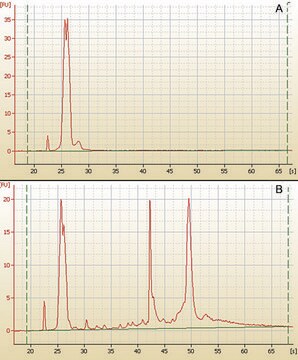SCT064
BioTracker NTP-Transporter Molecule
Quick and efficient transport of labeled NTPs into cells for live cell imaging of DNA replication, synthesis, etc. Labeling of DNA with fluorescent NTPs is one of the essential methods in cell cycle analysis.
Synonym(s):
Cell cycle detection, Live cell imaging probe, Live cell imaging probe, Cell cylce probe
About This Item
Recommended Products
assay
≥98% (H-NMR)
≥98% (HPLC)
≥98% (LC/MS)
≥98% (elemental analysis)
technique(s)
cell based assay: suitable
detection method
fluorometric
Related Categories
General description
BioTracker<TMSYMBOL></TMSYMBOL> NTP-Transporter Molecule has a receptor site, for selectively binding to the NTPs, and a cell penetrating agent. The transporter can bind to NTPs and quickly move them into cells without any apparent damage to the cell membrane or decrease in cell viability. The transported NTP is rapidly liberated from the complex and available in the nuclei for incorporation into DNA. Labeled NTPs can be used for live cell imaging, cell proliferation assays, synthetic biology studies, synthesizing artificial DNA, tracking cell division, research on active antiviral and anticancer nucleotides, among other things.
Application
Cell Imaging
Cell Cycle, DNA Replication & Repair
DNA Damage & Repair
Quality
Molar Mass: 3470.14 g/mol
Physical form
Storage and Stability
Note: Centrifuge vial briefly to collect contents at bottom of vial before opening.
Other Notes
Disclaimer
Storage Class
11 - Combustible Solids
wgk_germany
WGK 3
flash_point_f
Not applicable
flash_point_c
Not applicable
Certificates of Analysis (COA)
Search for Certificates of Analysis (COA) by entering the products Lot/Batch Number. Lot and Batch Numbers can be found on a product’s label following the words ‘Lot’ or ‘Batch’.
Already Own This Product?
Find documentation for the products that you have recently purchased in the Document Library.
Articles
Regulation of the cell cycle involves processes crucial to the survival of a cell, including the detection and repair of genetic damage as well as the prevention of uncontrolled cell division associated with cancer. The cell cycle is a four-stage process in which the cell 1) increases in size (G1-stage), 2) copies its DNA (synthesis, S-stage), 3) prepares to divide (G2-stage), and 4) divides (mitosis, M-stage). Due to their anionic nature, nucleoside triphosphates (NTPs), the building blocks of both RNA and DNA, do not permeate cell membranes.
Our team of scientists has experience in all areas of research including Life Science, Material Science, Chemical Synthesis, Chromatography, Analytical and many others.
Contact Technical Service


![Water, PCR Grade liquid, pkg of 25 mL (03315959001 [1 x 25 ml]), pkg of 25 mL (03315932001 [25 x 1 ml]), pkg of 100 mL (03315843001 [4 x 25 ml])](/deepweb/assets/sigmaaldrich/product/images/326/208/bac83eed-3c88-4738-b4b5-50d3b223dd1c/640/bac83eed-3c88-4738-b4b5-50d3b223dd1c.jpg)


